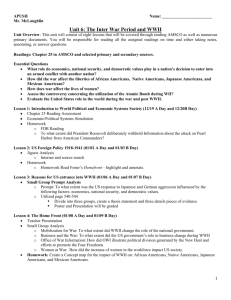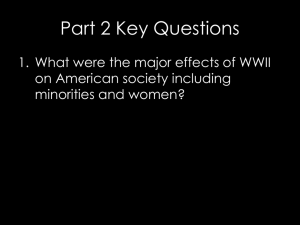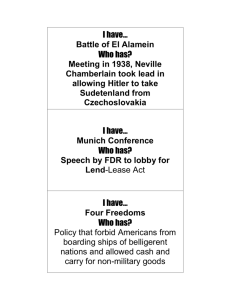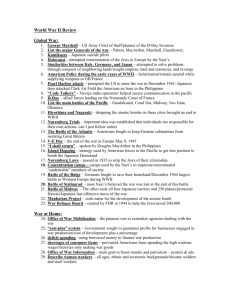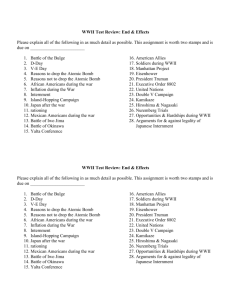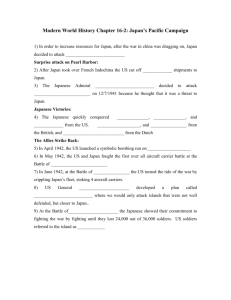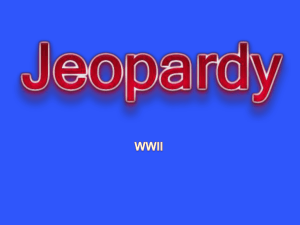Chapter 26
advertisement
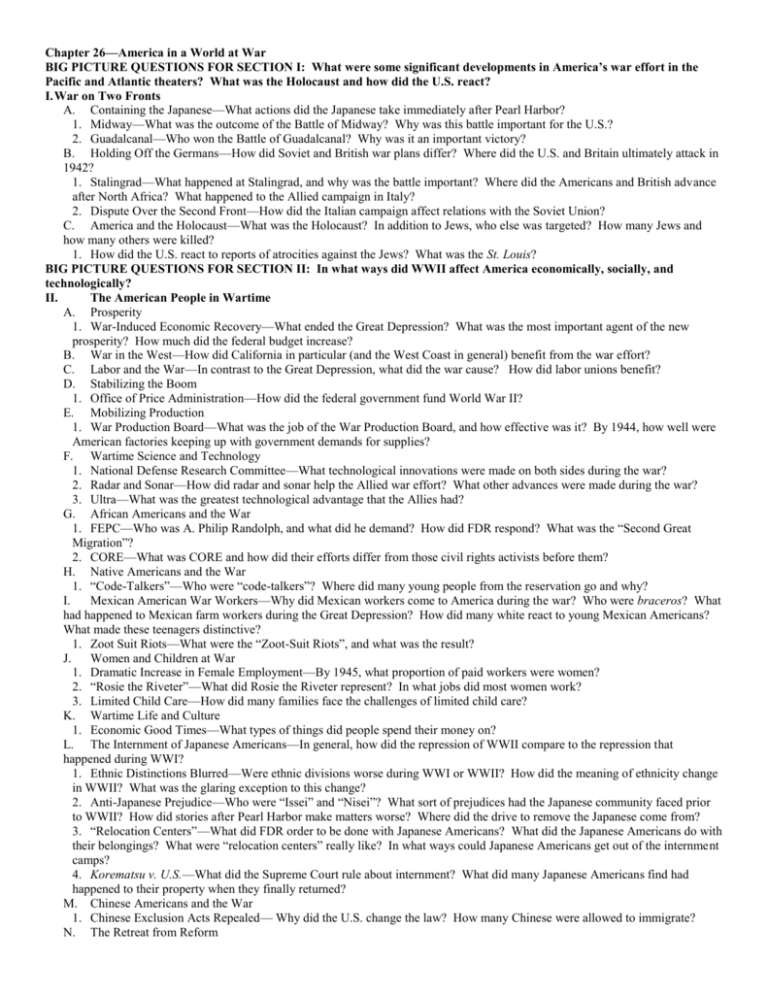
Chapter 26—America in a World at War BIG PICTURE QUESTIONS FOR SECTION I: What were some significant developments in America’s war effort in the Pacific and Atlantic theaters? What was the Holocaust and how did the U.S. react? I. War on Two Fronts A. Containing the Japanese—What actions did the Japanese take immediately after Pearl Harbor? 1. Midway—What was the outcome of the Battle of Midway? Why was this battle important for the U.S.? 2. Guadalcanal—Who won the Battle of Guadalcanal? Why was it an important victory? B. Holding Off the Germans—How did Soviet and British war plans differ? Where did the U.S. and Britain ultimately attack in 1942? 1. Stalingrad—What happened at Stalingrad, and why was the battle important? Where did the Americans and British advance after North Africa? What happened to the Allied campaign in Italy? 2. Dispute Over the Second Front—How did the Italian campaign affect relations with the Soviet Union? C. America and the Holocaust—What was the Holocaust? In addition to Jews, who else was targeted? How many Jews and how many others were killed? 1. How did the U.S. react to reports of atrocities against the Jews? What was the St. Louis? BIG PICTURE QUESTIONS FOR SECTION II: In what ways did WWII affect America economically, socially, and technologically? II. The American People in Wartime A. Prosperity 1. War-Induced Economic Recovery—What ended the Great Depression? What was the most important agent of the new prosperity? How much did the federal budget increase? B. War in the West—How did California in particular (and the West Coast in general) benefit from the war effort? C. Labor and the War—In contrast to the Great Depression, what did the war cause? How did labor unions benefit? D. Stabilizing the Boom 1. Office of Price Administration—How did the federal government fund World War II? E. Mobilizing Production 1. War Production Board—What was the job of the War Production Board, and how effective was it? By 1944, how well were American factories keeping up with government demands for supplies? F. Wartime Science and Technology 1. National Defense Research Committee—What technological innovations were made on both sides during the war? 2. Radar and Sonar—How did radar and sonar help the Allied war effort? What other advances were made during the war? 3. Ultra—What was the greatest technological advantage that the Allies had? G. African Americans and the War 1. FEPC—Who was A. Philip Randolph, and what did he demand? How did FDR respond? What was the “Second Great Migration”? 2. CORE—What was CORE and how did their efforts differ from those civil rights activists before them? H. Native Americans and the War 1. “Code-Talkers”—Who were “code-talkers”? Where did many young people from the reservation go and why? I. Mexican American War Workers—Why did Mexican workers come to America during the war? Who were braceros? What had happened to Mexican farm workers during the Great Depression? How did many white react to young Mexican Americans? What made these teenagers distinctive? 1. Zoot Suit Riots—What were the “Zoot-Suit Riots”, and what was the result? J. Women and Children at War 1. Dramatic Increase in Female Employment—By 1945, what proportion of paid workers were women? 2. “Rosie the Riveter”—What did Rosie the Riveter represent? In what jobs did most women work? 3. Limited Child Care—How did many families face the challenges of limited child care? K. Wartime Life and Culture 1. Economic Good Times—What types of things did people spend their money on? L. The Internment of Japanese Americans—In general, how did the repression of WWII compare to the repression that happened during WWI? 1. Ethnic Distinctions Blurred—Were ethnic divisions worse during WWI or WWII? How did the meaning of ethnicity change in WWII? What was the glaring exception to this change? 2. Anti-Japanese Prejudice—Who were “Issei” and “Nisei”? What sort of prejudices had the Japanese community faced prior to WWII? How did stories after Pearl Harbor make matters worse? Where did the drive to remove the Japanese come from? 3. “Relocation Centers”—What did FDR order to be done with Japanese Americans? What did the Japanese Americans do with their belongings? What were “relocation centers” really like? In what ways could Japanese Americans get out of the internment camps? 4. Korematsu v. U.S.—What did the Supreme Court rule about internment? What did many Japanese Americans find had happened to their property when they finally returned? M. Chinese Americans and the War 1. Chinese Exclusion Acts Repealed— Why did the U.S. change the law? How many Chinese were allowed to immigrate? N. The Retreat from Reform 1. Dismantling the New Deal—What major programs of the New Deal were allowed to expire during the war? 2. 1944 Election—Who won the election of 1944? How did the presidential ticket of the Democratic Party change? BIG PICTURE QUESTIONS FOR SECTION III: What were major events that helped to end WWII? III. The Defeat of the Axis A. The Liberation of France 1. Strategic Bombing—Where were some of the targets of Allied bombing, and what were the results? 2. D-Day—What was D-Day? When was it? Where was it? Who commanded it? What happened? 3. Battle of the Bulge—What was the Battle of the Bulge? Why was it important? 4. Germany Defeated—What happened to Hitler? When did Germany surrender? B. The Pacific Offensive—What was the “Burma Road”? 1. Battle of Leyte Gulf—Why was the Battle of Leyte Gulf memorable? What was the important result? What happened at Iwo Jima? 2. Okinawa—What happened at Okinawa? C. The Manhattan Project—Why did the U.S. and Britain begin work on an atomic bomb? What did Albert Einstein tell FDR? What it fission? 1. Enrico Fermi—What was the Manhattan Project? 2. The Trinity Bomb—What was the Trinity Bomb? D. Atomic Warfare 1. Debating the Bomb’s Use—What are some different viewpoints that people have had on the use of the atomic bomb? What did Truman believe the bomb to be? What other possible motives might Truman have had? 2. Hiroshima—What was the Enola Gay? What happened at Hiroshima? What were the effects? 3. Nagasaki—What happened at Nagasaki? What happened on August 14, 1945? In what position was the U.S. left after the war? How many a) combatants, and b) civilians died in the war? In comparison, how many Americans died?
